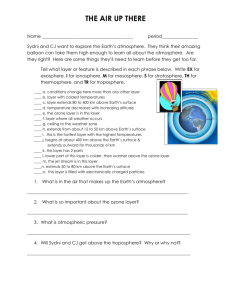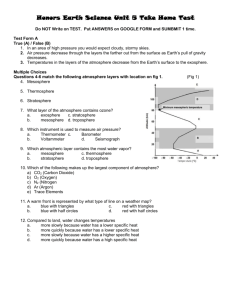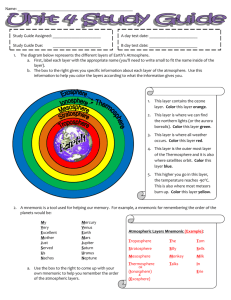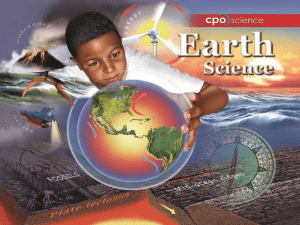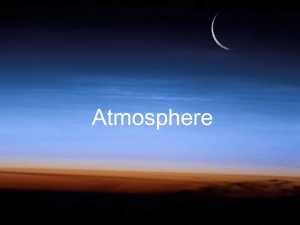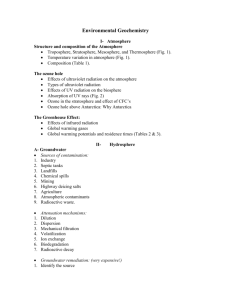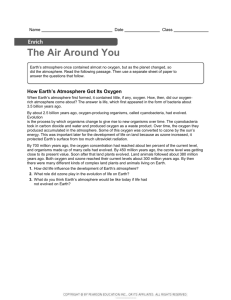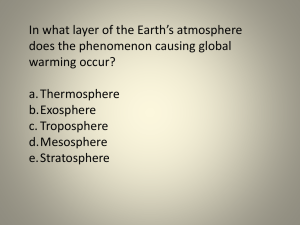Earth Science Unit 5 Take Home Test
advertisement
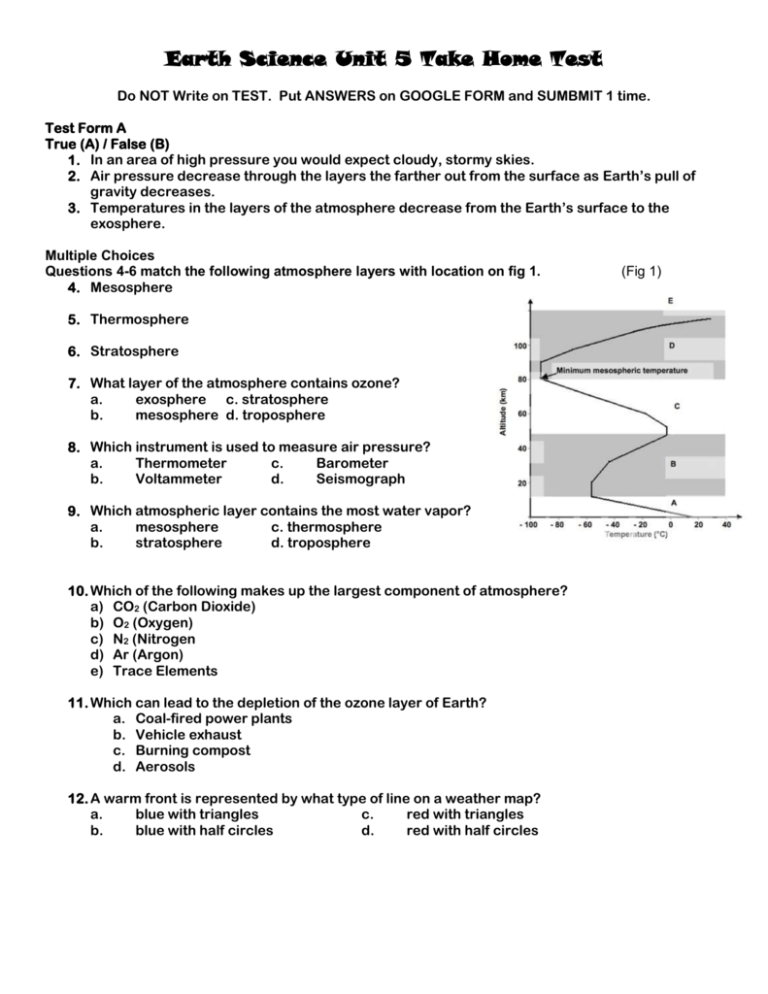
Earth Science Unit 5 Take Home Test Do NOT Write on TEST. Put ANSWERS on GOOGLE FORM and SUMBMIT 1 time. Test Form A True (A) / False (B) 1. In an area of high pressure you would expect cloudy, stormy skies. 2. Air pressure decrease through the layers the farther out from the surface as Earth’s pull of gravity decreases. 3. Temperatures in the layers of the atmosphere decrease from the Earth’s surface to the exosphere. Multiple Choices Questions 4-6 match the following atmosphere layers with location on fig 1. 4. Mesosphere 5. Thermosphere 6. Stratosphere 7. What layer of the atmosphere contains ozone? a. exosphere c. stratosphere b. mesosphere d. troposphere 8. Which instrument is used to measure air pressure? a. Thermometer c. Barometer b. Voltammeter d. Seismograph 9. Which atmospheric layer contains the most water vapor? a. mesosphere c. thermosphere b. stratosphere d. troposphere 10. Which of the following makes up the largest component of atmosphere? a) CO2 (Carbon Dioxide) b) O2 (Oxygen) c) N2 (Nitrogen d) Ar (Argon) e) Trace Elements 11. Which can lead to the depletion of the ozone layer of Earth? a. Coal-fired power plants b. Vehicle exhaust c. Burning compost d. Aerosols 12. A warm front is represented by what type of line on a weather map? a. blue with triangles c. red with triangles b. blue with half circles d. red with half circles (Fig 1) Earth Science Unit 5 Take Home Test 13. Compared to land, water changes temperatures a. more slowly because water has a lower specific heat b. more quickly because water has a lower specific heat c. more slowly because water has a higher specific heat d. more quickly because water has a high specific heat 14. According to the diagram, which season is it in the northern hemisphere? a. Fall b. Spring c. Winter d. Summer 15. What weather conditions are shown at letter D. a. Clear skies and cold temperatures b. Cloudy skies and warm temperatures c. Clear skies and warm temperatures d. Cloudy skies and cold temperatures 16. What type of weather front has entered area B. a. Warm b. Stationary c. Cold d. Occluded Earth Science Unit 5 Take Home Test 17. Dew or frost is most likely when a region is under the influence of a(n) a. cyclone b. anticyclone 18. Which statement describes the general movement of air masses? a. They move from areas of high pressure to areas of low pressure b. They move from areas of high altitude to areas of low altitude c. They move from areas of low humidity to areas of high humidity. d. They move from areas of low temperatures to areas of high temperatures. 19. In Figure 19-1, the lines on the weather map that connect points of equal pressure are ____. a. isobars c. contour lines b. isogrids d. isotherms 20. What causes wind? a. Differences in humidity b. Differences in elevation c. Differences in rates of condensation d. Differences in air pressure 21. On a weather map where isobars are closely spaced, the pressure gradient is relativity ____________ and winds are relatively _______________. a. Steep …. Strong b. Weak …. Strong c. Steep …. Weak d. Weak …. Weak Earth Science Unit 5 Take Home Test 22. In Figure 20-1, which air masses would be associated with cold, wet conditions? a. A and E c. A and D b. B and D d. G and F 23. What type of air mass is most likely to form over the North Atlantic Ocean? a. maritime tropical c. continental tropical b. maritime polar d. continental polar 24. A cT air mass is ____. a. cold and dry c. b. cold and wet d. hot and dry hot and wet 25. In the Northern Hemisphere, winds associated with a low-pressure system blow ____. a. counterclockwise toward the center b. clockwise toward the center c. clockwise outward from the center d. counterclockwise outward from the center 26. O2 molecules are called _________________, O3 molecules are called __________________. a. Ozone, Oxygen c. Ozone, Ozone b. Oxygen, Ozone d. Oxygen, Oxygen 27. O2 molecules are ________ concentrated at sea level vs mountain peak elevations. a. More b. Less Earth Science Unit 5 Take Home Test Use the illustrations of weather tools below to answer the question. 1) 2) 3) 4) 28. Which weather tool would be used to measure wind speed? a. Tool #1 b. Tool #2 c. Tool #3 d. Tool #4 29. Which weather tool would be used to measure water vapor in the air? a. Tool #1 b. Tool #2 c. Tool #3 d. Tool #4 30. In a convection current, warm air ________ and cold air _________. a. Rises and Sinks b. Sinks and Rises c. Rises and Rises d. Sinks and Sinks 31. The eye wall of a hurricane has the ____. a. highest wind speeds c. most intense rainfall b. warmest temperatures d. highest air pressure 32. Which clouds are often associated with thunder and lightning? a. cirrostratus c. cumulonimbus b. altostratus d. nimbostratus 33. What is a major source of air pollution created by humans? a. Hydroelectric plants b. Industrial factories c. Reforestation d. Nuclear power Earth Science Unit 5 Take Home Test 34. What phenomenon naturally warms Earth’s lower atmosphere and surface? a. the formation of sunspots c. global warming b. changes in the shape of Earth’s orbit d. the greenhouse effect 35. The two most important heat-absorbing gases in the lower atmosphere are ____. a. oxygen and nitrogen c. argon and hydrogen b. ozone and chlorofluorocarbon d. water vapor and carbon dioxide 36. What is the relationship between fossil fuels and the greenhouse effect? a. Burning fossil fuels decreases incoming solar radiation. b. Burning fossil fuels decreases the absorption capacity of greenhouse gases. c. Burning fossil fuels lowers the greenhouse effect. d. Burning fossil fuels releases carbon dioxide into the atmosphere. 37. Throughout the twentieth century, Earth’s average surface temperature ____. a. increased c. stayed the same b. decreased d. fluctuated wildly 38. Which type of air pollutant is colorless, odorless and a toxic gas. Introduction of this gas interferes with the atmospheres ability to cleanse itself and can cause human death. Common sources include gas furnaces, space heaters, car exhaust and fireplaces. a. PM b. O3 c. SO2 d. CO e. VOC 39. Clouds are classified by? a. Temperature b. Shape c. Moisture Content d. Altitude e. Pressure System 40. Name the cloud: Appears as detached clouds in the form of white, delicate, hair like patches. a. Cirrostratus b. Altostratus c. Cirrus d. Cumulonimbus e. Stratus 41. Name the Cloud: The thunderstorm cloud that can grow over 10 miles high. Flattening occurs because the top of the troposphere. a. Cirrostratus b. Altostratus c. Cirrus d. Cumulonimbus e. Stratus Earth Science Unit 5 Take Home Test Matching: Match the following vocabulary words with its definition. A. Ozone F. Carbon Dioxide K. Air masses B. Humidity G. Dew point L. Fronts C. Temperature H. Water Cycle M. Condensation D. Heat I. Troposphere N. Convection Current E. Mesopshpere J. Thermosphere O. Exosphere P. Stratosphere Q. Magnetosphere R. Magnetic Field S. Cyclone T. Anti-cyclone 42. Huge bodies of air that form over water or land in tropical or Polar Regions. 43. A form of oxygen found in the stratosphere, which protects Earth from harmful solar radiation. 44. The degree or intensity of heat present in a substance. 45. The atmospheric temperature at which water vapor condenses (dependent upon pressure and humidity). 46. A general term referring to the amount of water vapor in the air but no in liquid drops. 47. A low-pressure center characterized by a counter clock wise flow of air pushing toward the center in the Northern Hemisphere. 48. This is the easiest test ever, because I was a responsible student who complete all of my assignments and kept them in an organized binder to use on this test. A. TRUE
